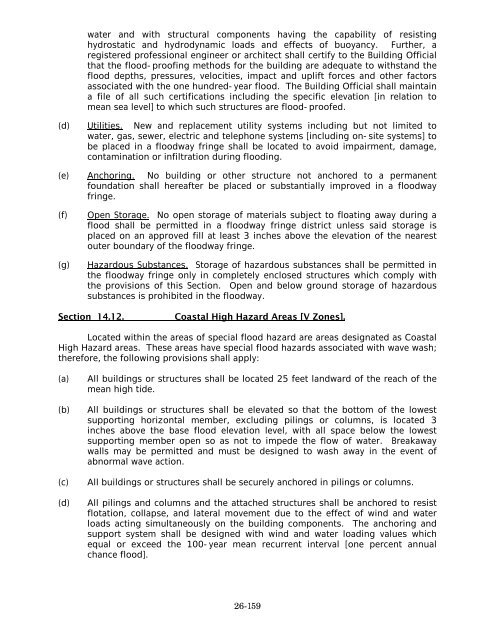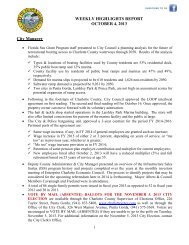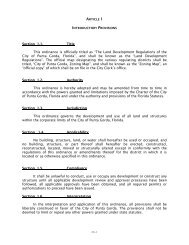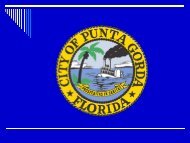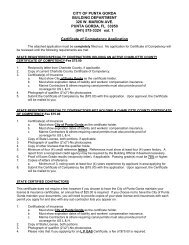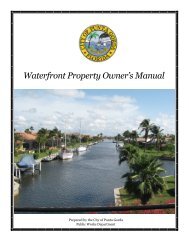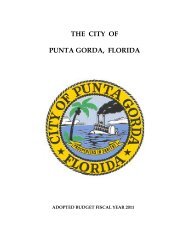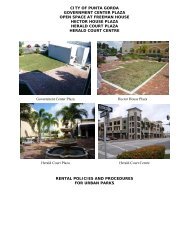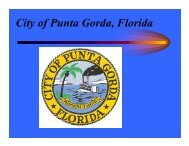Chapter 26 - City of Punta Gorda
Chapter 26 - City of Punta Gorda
Chapter 26 - City of Punta Gorda
You also want an ePaper? Increase the reach of your titles
YUMPU automatically turns print PDFs into web optimized ePapers that Google loves.
water and with structural components having the capability <strong>of</strong> resisting<br />
hydrostatic and hydrodynamic loads and effects <strong>of</strong> buoyancy. Further, a<br />
registered pr<strong>of</strong>essional engineer or architect shall certify to the Building Official<br />
that the flood-pro<strong>of</strong>ing methods for the building are adequate to withstand the<br />
flood depths, pressures, velocities, impact and uplift forces and other factors<br />
associated with the one hundred-year flood. The Building Official shall maintain<br />
a file <strong>of</strong> all such certifications including the specific elevation [in relation to<br />
mean sea level] to which such structures are flood-pro<strong>of</strong>ed.<br />
(d) Utilities. New and replacement utility systems including but not limited to<br />
water, gas, sewer, electric and telephone systems [including on-site systems] to<br />
be placed in a floodway fringe shall be located to avoid impairment, damage,<br />
contamination or infiltration during flooding.<br />
(e) Anchoring. No building or other structure not anchored to a permanent<br />
foundation shall hereafter be placed or substantially improved in a floodway<br />
fringe.<br />
(f) Open Storage. No open storage <strong>of</strong> materials subject to floating away during a<br />
flood shall be permitted in a floodway fringe district unless said storage is<br />
placed on an approved fill at least 3 inches above the elevation <strong>of</strong> the nearest<br />
outer boundary <strong>of</strong> the floodway fringe.<br />
(g) Hazardous Substances. Storage <strong>of</strong> hazardous substances shall be permitted in<br />
the floodway fringe only in completely enclosed structures which comply with<br />
the provisions <strong>of</strong> this Section. Open and below ground storage <strong>of</strong> hazardous<br />
substances is prohibited in the floodway.<br />
Section 14.12. Coastal High Hazard Areas [V Zones].<br />
Located within the areas <strong>of</strong> special flood hazard are areas designated as Coastal<br />
High Hazard areas. These areas have special flood hazards associated with wave wash;<br />
therefore, the following provisions shall apply:<br />
(a) All buildings or structures shall be located 25 feet landward <strong>of</strong> the reach <strong>of</strong> the<br />
mean high tide.<br />
(b) All buildings or structures shall be elevated so that the bottom <strong>of</strong> the lowest<br />
supporting horizontal member, excluding pilings or columns, is located 3<br />
inches above the base flood elevation level, with all space below the lowest<br />
supporting member open so as not to impede the flow <strong>of</strong> water. Breakaway<br />
walls may be permitted and must be designed to wash away in the event <strong>of</strong><br />
abnormal wave action.<br />
(c) All buildings or structures shall be securely anchored in pilings or columns.<br />
(d) All pilings and columns and the attached structures shall be anchored to resist<br />
flotation, collapse, and lateral movement due to the effect <strong>of</strong> wind and water<br />
loads acting simultaneously on the building components. The anchoring and<br />
support system shall be designed with wind and water loading values which<br />
equal or exceed the 100-year mean recurrent interval [one percent annual<br />
chance flood].<br />
<strong>26</strong>-159


